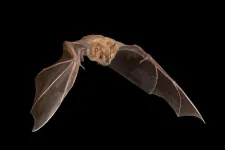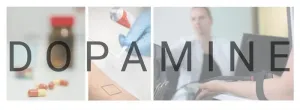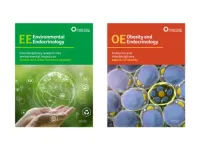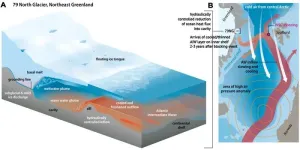(Press-News.org) The "popcorn planet" is back in the spotlight! Using NASA's James Webb Space Telescope (JWST), a team of international astronomers has discovered new atmospheric details on WASP-107b, an exoplanet with a puffed-up atmosphere due to tidal heating. Previously described as an extremely low-density "popcorn planet" by researchers, WASP-107b has once again proven to be an intriguing subject, revealing even more surprising characteristics about its inflated and dynamic atmosphere.
WASP-107b, a gas giant about the size of Jupiter but with just one-tenth of its mass, has long baffled astronomers with its puffy, inflated state. Now, JWST’s advanced observations have provided an even closer look, revealing an unexpected east-west asymmetry in its atmosphere—marking one of the first times such details have been observed in an exoplanet.
"Our previous findings showed that WASP-107b is extraordinarily puffed up, almost as if the planet had popped like a kernel of popcorn under its own heat," explained co-author Luis Welbanks, a 51 Pegasi b Fellow at Arizona State University's School of Earth and Space Exploration. "With JWST, we are getting a clearer picture of what’s happening in its atmosphere in three-dimensions, and it turns out there’s even more to munch on!"
The study, published in Nature Astronomy, was led by Matthew Murphy, a graduate student at the University of Arizona's Steward Observatory, with contributions from Welbanks and Associate Professor Michael Line, from Arizona State University.
Earlier in 2024, the previous study led by ASU researchers revealed that WASP-107b had a significantly hotter interior and a more massive core than previously hypothesized thanks to the broadband spectrum showing simultaneous detections of carbon-, oxygen-, nitrogen- and sulfur-bearing molecules. Now, the reanalysis of JWST observations uncover an east-west atmospheric asymmetry. This feature suggests differences in the properties between the two sides of the exoplanet.
"The source of this asymmetry is intriguing. While our initial analysis suggests that the asymmetries may be due to one limb of the planet being more cloudy than the other, this could also be linked to how heat is transported across the planet's atmosphere," said Line. "It’s as if one side of WASP-107b is cooking faster than the other!"
WASP-107b is tidally locked to its star, meaning one side always faces the star, basking in constant daylight, while the other side remains in perpetual darkness. This condition, combined with the planet’s low gravity and inflated state, makes WASP-107b an ideal candidate for studying the unique processes at work in exoplanetary atmospheres.
To study the planet’s atmosphere, researchers used a technique called transmission spectroscopy, which involves analyzing the starlight that filters through the exoplanet's atmosphere as it passes in front of its star. The high sensitivity of JWST allowed the team to isolate and examine the signals from the eastern and western edges of the atmosphere separately, something never before achieved with this level of detail.
"The high precision of JWST’s instruments is like having a magnifying glass for planets," said Welbanks. "We can now look at specific processes happening on each side of WASP-107b’s atmosphere, giving us valuable insights into how climate works in these extreme conditions"
WASP-107b’s atmosphere, which reaches temperatures around 890 degrees Fahrenheit, sits in an intermediate range between the planets in our solar system and the hottest exoplanets known. This makes it an important target for understanding the diverse climates and atmospheric dynamics of exoplanets.
"Traditionally, our observing techniques don't work as well for these intermediate planets, so there's been a lot of exciting open questions that we can finally start to answer," Murphy said. "For example, some of our models told us that a planet like WASP-107b shouldn't have this asymmetry at all – so we're already learning something new."
The researchers now plan to conduct additional observations to delve deeper into what drives this atmospheric asymmetry. These ongoing studies will help astronomers piece together the puzzle of how such inflated exoplanets maintain their structure and how heat, winds, and atmospheric chemistry interact to create the unique conditions observed on WASP-107b.
For further details, you can revisit the earlier press release on WASP-107b's unique 'popping' behavior from 2024 here.
END
More to munch on: The popcorn planet WASP-107b unveils new atmospheric details
2024-09-24
ELSE PRESS RELEASES FROM THIS DATE:
Innovative electrolytes could transform steelmaking and beyond
2024-09-24
The lifeblood of any battery is the electrolyte. It is the medium through which positively charged elements (cations) migrate en masse between the positive and negative electrodes. By this means, batteries discharge to provide energy and charge to store energy. Scientists call this an electrochemical process.
Electrolytes are central to the development of different electrochemical processes, as well. For example, they could be used in converting iron ore into purified iron metal or iron alloys. A challenge is that the electrolyte must remain stable under extreme operating conditions and avoid side reactions that reduce energy efficiency. The payoff ...
Planting seeds for safer farming
2024-09-24
Per- and polyfluoroalkyl substances (PFAS) are human-made chemicals that were introduced in the 1940s. PFAS are used to create a variety of products including water-resistant clothing, non-stick cookware, and firefighting foams.
Unfortunately, PFAS can have negative effects on health, including increases in cholesterol levels and changes to liver function. Using PFAS-containing products can lead to their presence in the treated wastewater and treated sludge (referred to as biosolids). When grown on biosolid-amended farmland soils or irrigated with treated wastewater, crops can bioaccumulate PFAS. The PFAS-accumulated crops can be consumed directly by the public or indirectly ...
Fruit-only diet improves bats’ immune response to viruses
2024-09-24
Fruit bats generate more diverse antibodies than mice, but overall have a weaker antibody response, according to a new study published September 24th in the open-access journal PLOS Biology by Dan Crowley from Cornell University, USA, and colleagues.
Bats are well-known reservoirs for viruses with pandemic potential. While these viruses typically do not cause disease in bats, they can prove deadly in humans. Spillover events—transmission of a virus from a reservoir population (eg, bats) to a new host population ...
Placebo pain relief and positive treatment expectations are not caused by dopamine
2024-09-24
New findings argue against a direct causal role for dopamine during the experience of a treatment effect in the establishment of positive treatment expectations and placebo analgesia in healthy volunteers, according to a study published September 24th in the open-access journal PLOS Biology by Ulrike Bingel from University Hospital Essen, Germany, and colleagues.
Dopamine-based reward and learning mechanisms have been suggested to contribute to placebo effects. However, the exact role of the brain messenger molecule dopamine in their generation and maintenance is still unclear. ...
New guideline details how to manage CVD risk before, during & after noncardiac surgery
2024-09-24
Guideline highlights:
The American Heart Association and the American College of Cardiology joint guideline addressing cardiovascular evaluation and management of patients before, during and after noncardiac surgery reviews a decade of new evidence and provides updates since the last guideline in 2014.
The updates in the guideline are intended for patients scheduled for noncardiac surgery from preoperative evaluation through postoperative care and include appropriate use of cardiovascular testing and screening, management of cardiovascular conditions and risks, and recommendations for those taking sodium-glucose ...
Silvia Cavagnero to receive 2025 Emily M. Gray Award
2024-09-24
ROCKVILLE, MD – The Biophysical Society is pleased to announce that Silvia Cavagnero, PhD, of the University of Wisconsin-Madison, has been named the recipient of the 2025 Emily M. Gray Award. Cavagnero will be honored at the Society’s 69th Annual Meeting, being held in Los Angeles, California from February 15-19, 2025.
Cavagnero is being honored for developing courses, innovating instructional methods, mentoring students at all levels, and promoting diversity in biophysics.
“Silvia is an accomplished biophysicist and a born educator,” ...
European Society of Endocrinology expands journal portfolio with the launch of Environmental Endocrinology and Obesity and Endocrinology
2024-09-24
The European Society of Endocrinology (ESE) is delighted to announce the launch of two new multidisciplinary, open-access journals, Environmental Endocrinology and Obesity and Endocrinology. The Journals will be published by Oxford University Press, with the launch issues scheduled for Q2 2025. Submissions are now being welcomed via the Journals' websites.
Environmental Endocrinology will publish high-quality clinical, translational, and basic research on all aspects of environmental impacts on hormone systems in humans and living systems, incorporating the One Health perspective. The Journal will welcome submissions from a broad range ...
Atmospheric blocking slows ocean-driven melting of Greenland’s largest glacier tongue
2024-09-24
Northeast Greenland is home to the 79° N Glacier – the country’s largest floating glacier tongue, but also one seriously threatened by global warming: warm water from the Atlantic is melting it from below. Experts from the Alfred Wegener Institute have however now determined that the temperature of the water flowing into the glacier cavern declined from 2018 to 2021, even though the ocean has steadily warmed in the region over the past several decades. This could be due to temporarily changed atmospheric circulation patterns. ...
Improved cement to protect the living treasures of our coastlines
2024-09-24
WASHINGTON, Sept. 24, 2024 – Coastlines are vital to our world’s ecology and economy. Coastal ecosystems help maintain biodiversity, provide natural barriers against erosion, storms, and flooding, and act as large carbon sinks to reduce greenhouse gases. Sustainable fisheries and seaside tourist venues support local economies.
Natural coastlines, including coral reefs, marshes, and mangroves, are complete and stable, capable of self-regulation and restoration. That is, unless human interventions, such as urbanization, overdevelopment, pollution, and human-made erosion, make these areas vulnerable to devastation.
Artificial coastlines, ...
Absolute and functional iron deficiency in the US
2024-09-24
About The Study: The findings of this study suggest that absolute and functional iron deficiency affect a large proportion of American adults even in the absence of anemia, heart failure, or chronic kidney disease. Further research on the role of functional iron deficiency in adverse health outcomes and on iron deficiency screening strategies is needed.
Corresponding author: To contact the corresponding author, Leo F. Buckley, Pharm.D., M.P.H., email lfbuckley@bwh.harvard.edu.
To access the embargoed ...






